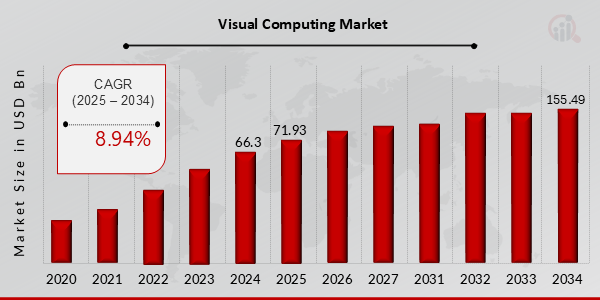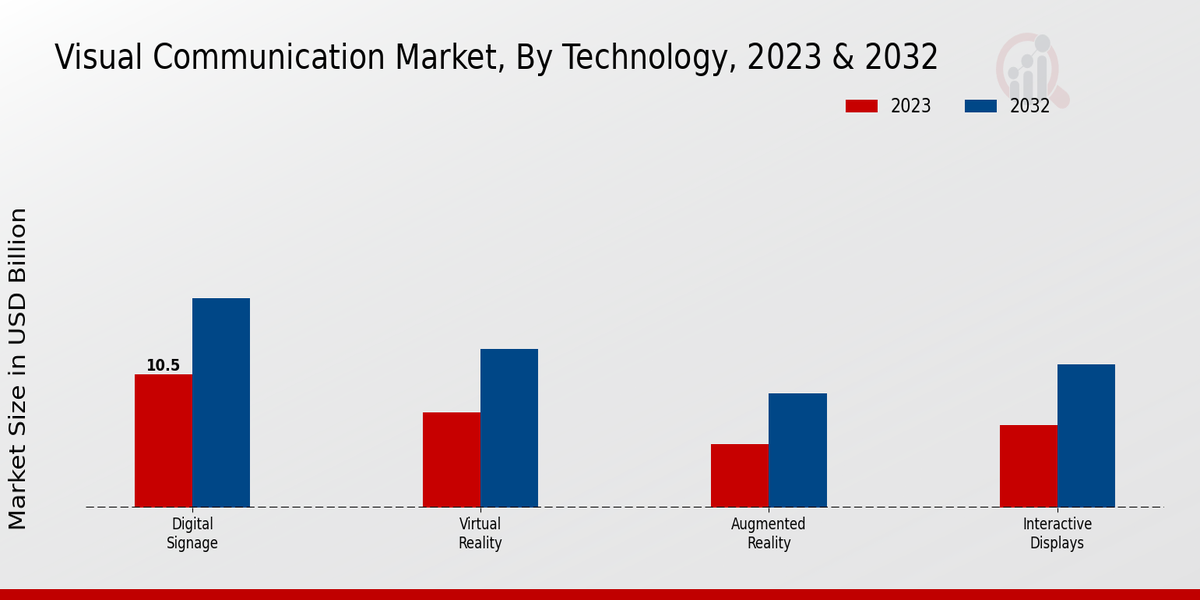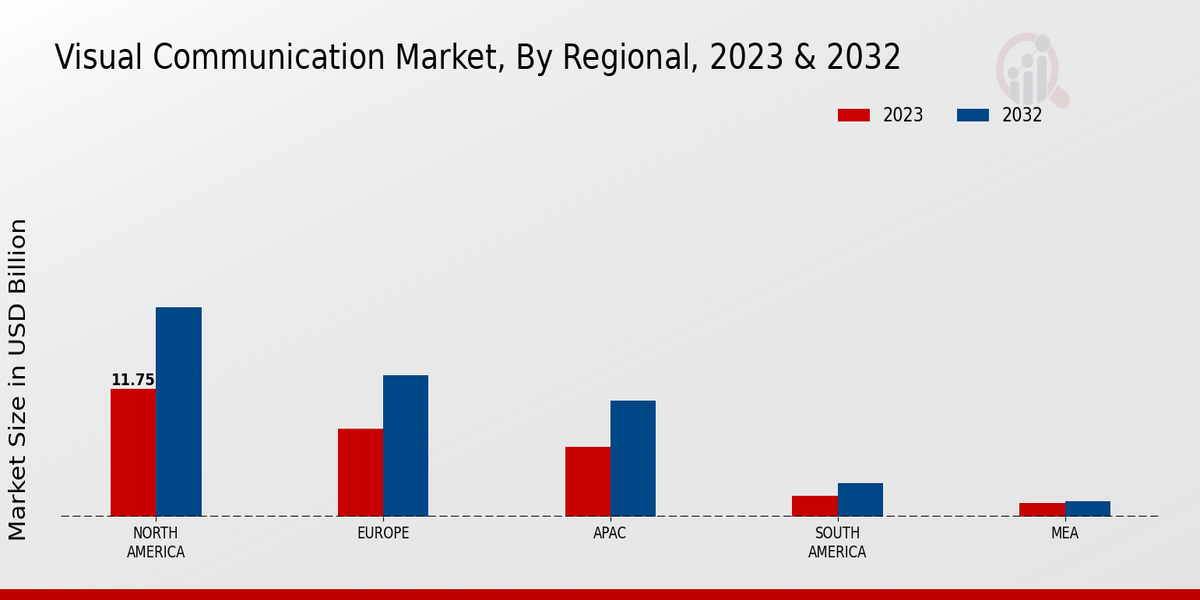Global Visual Computing Market Overview
Visual Computing Market Size was estimated at 66.31 (USD Billion) in 2024. The Visual Computing Market Industry is expected to grow from 71.93 (USD Billion) in 2025 to 155.49 (USD Billion) till 2034, exhibiting a compound annual growth rate (CAGR) of 8.94% during the forecast period (2025 - 2034).
Key Visual Computing Market Trends Highlighted
The Visual Computing Market is increasingly influenced by the rapid advancements in technology, particularly around artificial intelligence, machine learning, and real-time data processing.
The growing demand for immersive experiences in gaming, entertainment, and virtual reality is driving this market forward. Businesses are seeking to enhance user engagement through improved graphical interfaces and visual analytics, making high-quality visual computing solutions essential.
Additionally, the rise in cloud computing enables more extensive data storage and processing capabilities, thus facilitating complex visual computations that were not feasible before.
Opportunities lie in sectors like healthcare, where visual computing can enhance diagnostic imaging and treatment planning. The automotive industry is also exploring visual computing for autonomous vehicles, while education technology adapts these solutions for interactive learning experiences.
Smart cities and home automation also create a pathway for innovative visual solutions to monitor and manage resources effectively. As companies look for competitive advantages, integrating visual computing into their operations opens up new possibilities for growth.
Recent trends show a shift toward more user-friendly interfaces and the integration of augmented reality and virtual reality in various applications. The rise of remote work and online engagement has further fueled demand for immersive technologies that can create more interactive environments.
As companies adapt to these changes, they are investing in advanced visualization techniques to improve decision-making, enhance marketing strategies, and streamline operations.
Overall, the Visual Computing Market is witnessing a transformative phase driven by evolving consumer expectations and technological innovations that expand its reach across diverse industries.

Source: Primary Research, Secondary Research, MRFR Database and Analyst Review
Visual Computing Market Drivers
Rising Demand for Enhanced User Experience
The Visual Computing Market is experiencing a significant upswing driven by the rising demand for enhanced user experience across several sectors.
The advancement of technology has led to a dramatic increase in the expectation of visually appealing, interactive interfaces in applications such as gaming, multimedia, and virtual reality. Users today are looking for immersive experiences that can be delivered through high-quality visual computing solutions.
With businesses and developers striving to retain user engagement and satisfaction, the focus on improving visual output has sharply intensified.
This escalating demand is fueled by the rapid proliferation of high-definition displays, augmented reality, and virtual reality experiences, which have begun to permeate various sectors such as retail, entertainment, and education.
As companies increasingly harness the potential of visually stimulating content to capture consumer interest, a significant portion of the investment is being redirected toward the development of advanced visual computing technologies that promise to deliver experiences akin to real-life interactions.
This shift is creating a fertile ground for the Visual Computing Market, as investments in graphic processing units, augmented models, and rendering solutions are surging to meet the rising demand.
Moreover, the industry's pivot towards machine learning and artificial intelligence is also influencing the user experience, enabling more personalized and responsive visual interfaces.
As technology continues to evolve and the appetite for cutting-edge visual solutions grows, the momentum driving the Visual Computing Market is expected to accelerate at a robust pace.
Growth of Artificial Intelligence and Machine Learning
The integration of artificial intelligence (AI) and machine learning (ML) technologies into visual computing systems has emerged as a key driver for the Visual Computing Market.
These advancements enhance the processing capability of visual computing solutions, enabling the automatic analysis and interpretation of visual data, thus unlocking new possibilities in various fields such as healthcare, automotive, and security.
Companies are increasingly investing in AI-driven visual computing tools that leverage advanced algorithms to improve image recognition, video analysis, and object detection, setting the stage for wide-ranging applications that require real-time performance and efficiency.
Expansion of Gaming and Entertainment Industries
The ongoing expansion of the gaming and entertainment industries is significantly fueling the Visual Computing Market. With the increasing popularity of online gaming, e-sports, and high-definition content, there is a pressing demand for advanced visual computing technologies.
This sector is not only consuming more graphics processing power but also demanding innovative visual effects and immersive experiences. As developers aim to create visually rich and engaging games, investments in visual computing technologies are poised to grow, thereby driving the market further.
Visual Computing Market Segment Insights:
Visual Computing Market Application Insights
The Visual Computing Market is projected to experience substantial growth, particularly within the Application segment, which plays a key role in driving industry development.
The Entertainment sector was one of the most dominant, valued at 20.0 USD billion in 2023 and expected to reach 45.0 USD billion by 2032, reflecting its majority holding in the market due to the increasing demand for immersive and engaging content across various platforms.
Healthcare, another vital sector, was valued at 10.0 USD billion and is projected to rise to 25.0 USD billion by 2032. The adoption of visual computing technologies in medical imaging, patient monitoring, and even virtual reality for training purposes underscores the importance and growth potential within this vertical.
Education, valued at 8.0 USD billion in 2023, is also gaining traction as institutions increasingly incorporate visual computing technologies to enhance learning experiences through interactive tools and visualization methods, expected to grow to 15.0 USD billion by 2032.
Meanwhile, the Art and Design segment, with a valuation of 7.0 USD billion, is forecasted to reach 20.0 USD billion in 2032, indicating the rising need for innovative tools that facilitate creativity and design processes.
The Gaming sector, which is experiencing rapid growth, has a market size of 10.63 USD billion in 2023 and is anticipated to rise to 15.2 USD billion. The interactive nature of gaming and advancements in graphics technology often place visual computing at the forefront of gaming experience, making it a significant contributor to market growth.
Overall, the Visual Computing Market segmentation highlights the diverse applications of visual computing technologies, with Entertainment leading the charge. Market trends indicate a strong demand across all segments, driven by the need for richer user experience and enhanced content creation capabilities.
As the industry faces challenges, such as the need for substantial investments in technology and the market's dynamic nature, opportunities abound in meeting the escalating demands across sectors like Healthcare and Education.
The increasing integration of visual computing in various applications not only enhances operational efficiencies but also facilitates innovation, thus contributing to the overall market growth. As such, the importance of each segment varies, with Entertainment and Healthcare demonstrating key dominance due to their substantial market valuations and relevance in society.

Source: Primary Research, Secondary Research, MRFR Database and Analyst Review
Visual Computing Market Technology Insights
The market encompasses various segmented areas, prominently featuring Virtual Reality (VR), Augmented Reality (AR), Mixed Reality (MR), 3D Graphics, and Image Processing.
VR and AR have gained importance in sectors like gaming, education, and healthcare, offering immersive experiences that enhance user engagement and learning. MR integrates real and digital worlds, leading to innovative applications in training and simulation.
The integration of 3D graphics plays a crucial role in visual storytelling and data visualization, whereas image processing is fundamental for enhancing visual content and applications in various industries.
As these technologies evolve, they contribute significantly to the overall Visual Computing Market revenue, riding on trends such as increased device adoption and the rise of the metaverse, leading to promising opportunities for growth and innovation in this industry.
Continuous developments in hardware and software are expected to bolster market expansion, creating a dynamic environment for future advancements.
Visual Computing Market End Use Insights
The segment encompasses a range of applications, including Consumer Electronics, Automotive, Aerospace, Healthcare, and Industrial sectors, which are pivotal in driving market demand. Consumer Electronics has become increasingly significant due to the proliferation of smart devices and the growing trend for immersive experiences.
In the Automotive industry, visual computing technologies enhance safety through advanced driver-assistance systems (ADAS) and autonomous vehicles.
The Aerospace sector utilizes visual computing for simulation and training, improving operational efficiency. Healthcare applications leverage this technology for improved diagnostics, patient management, and virtual surgeries, indicating its crucial role in advancing medical practices.
Industrial applications, too, benefit from visual computing for enhancing productivity and process optimization. The diverse End Use of the Visual Computing Market reveals its wide-ranging implications across industries, underscoring the growing need for innovative visual solutions to meet modern challenges.
In the years ahead, these sectors will play a critical role in the market's trajectory, driving further advancements and market growth.
Visual Computing Market Deployment Model Insights
An essential aspect of this market is the Deployment Model, which includes On-premises, Cloud-Based, and Hybrid solutions. The On-premises model provides businesses with direct control and security, making it a popular choice for companies with stringent data regulations.
In contrast, Cloud-Based deployment offers flexibility and scalability, catering to organizations that prioritize cost-effectiveness and remote accessibility, hence driving its growth in various sectors.
The Hybrid model, combining the advantages of both On-premises and Cloud-Based solutions, facilitates seamless integration, empowering businesses to choose the best of both worlds based on their unique needs.
As the Visual Computing Market continues to expand, understanding the segmentation within Deployment Models will be fundamental to navigating growth drivers, market trends, challenges, and opportunities that are shaping the market landscape.
Visual Computing Market Regional Insights
North America dominated this segment, holding a significant share valued at 25.2 USD billion, expected to increase to 54.0 USD billion by 2032. This growth can be attributed to the region's technological advancements and high adoption rates of visual computing applications in industries such as gaming and design.
Europe followed, valued at 15.0 USD billion in 2023 and projected to reach 32.5 USD billion in 2032, benefitting from a robust creative sector and strong investment in digital transformation.
The APAC region, valued at 10.0 USD billion in 2023, is also experiencing rapid market growth due to rising demand for visual computing technologies in various sectors, expected to rise to 24.0 USD billion by 2032.
South America and MEA, with valuations of 3.0 USD billion and 2.43 USD billion, respectively, in 2023, showcased emerging opportunities, although they currently hold smaller shares in the Visual Computing Market.
However, both regions are witnessing increased investments in technology and infrastructure, which may foster market growth moving forward.

Source: Primary Research, Secondary Research, MRFR Database and Analyst Review
Visual Computing Market Key Players and Competitive Insights:
The Visual Computing Market is experiencing significant evolution driven by advancements in technology, rising demand for high-quality graphics, and an increasing focus on immersive experiences. In this competitive landscape, players within the market are striving to leverage innovation, enhance performance, and differentiate their offerings.
Factors such as the growing adoption of augmented reality (AR) and virtual reality (VR) applications, along with the surge in gaming and entertainment, are reshaping the dynamics of visual computing solutions. Companies are focusing on collaboration, strategic partnerships, and data analytics to capture a more extensive customer base, thus heightening the competitive atmosphere.
TCL has established a robust presence in the Visual Computing Market, capitalizing on its strengths in innovation and product differentiation. With a well-recognized brand, TCL has been at the forefront of developing state-of-the-art visual computing products that cater to both consumer and professional segments.
Its relentless focus on research and development enables TCL to introduce cutting-edge technologies in display and image processing, setting it apart from competitors.
The company's commitment to sustainability and cost-effectiveness in its product offerings resonates well with environmentally conscious consumers while providing strong value to businesses looking to enhance their visual computing capabilities.
Furthermore, TCL's strategic collaborations with software developers and content creators bolster its position by ensuring seamless integration and enhanced user experiences, fostering loyalty among its clientele.
Hewlett Packard Enterprise plays a critical role in the Visual Computing Market through its focus on high-performance computing and data-driven solutions. The company brings a wealth of experience in delivering comprehensive visual computing infrastructures and solutions that cater to demanding industries such as gaming, healthcare, and design.
Hewlett Packard Enterprise has forged strong relationships within the enterprise sector, making it a trusted partner for organizations requiring advanced visual computing technologies. The adaptability and scalability of its products, combined with a strong support framework, enable users to optimize their visual workflows effectively.
By emphasizing a customer-centric approach and harnessing next-generation technologies such as artificial intelligence and machine learning, Hewlett Packard Enterprise continuously enhances its offerings to remain competitive in a rapidly evolving market landscape.
Key Companies in the Visual Computing Market Include:
- TCL
- Hewlett Packard Enterprise
- Samsung
- Intel
- Alibaba
- Unity Technologies
- Microsoft
- Apple
- Qualcomm
- Autodesk
- NVIDIA
- Adobe
- Siemens
- AMD
- Google
Visual Computing Market Industry Developments
The Visual Computing Market has seen significant advancements recently, particularly with major players like NVIDIA and AMD innovating in graphics processing units essential for gaming and AI applications. Companies such as Apple and Microsoft are increasingly investing in augmented and virtual reality technologies to enhance user experiences.
Moreover, Intel's push into integrated graphics solutions reflects a broader trend toward more advanced visual computing capabilities across various devices. Samsung is making strides in display technology, while Adobe continues to roll out updates in creative software that leverage machine learning for enhanced visual effects.
Notably, acquisitions are shaping the landscape, with Unity Technologies pursuing strategic partnerships to bolster its real-time 3D content creation capabilities. Furthermore, the market valuation is experiencing growth as companies like Qualcomm ramp up their offerings in mobile visual computing, creating a ripple effect across sectors including entertainment and enterprise solutions.
The rising demand for visual computing across industries is expected to drive further innovation and collaboration among these major players.
Visual Computing Market Segmentation Insights
Visual Computing Market Application Outlook
- Entertainment
- Healthcare
- Education
- Art and Design
- Gaming
Visual Computing Market Technology Outlook
- Virtual Reality
- Augmented Reality
- Mixed Reality
- 3D Graphics
- Image Processing
Visual Computing Market End Use Outlook
- Consumer Electronics
- Automotive
- Aerospace
- Healthcare
- Industrial
Visual Computing Market Deployment Model Outlook
- On-premises
- Cloud-Based
- Hybrid
Visual Computing Market Regional Outlook
- North America
- Europe
- South America
- Asia Pacific
- Middle East and Africa
| Report Attribute/Metric |
Details |
|
Market Size 2024
|
USD 66.31 Billion
|
|
Market Size 2025
|
USD 71.93 Billion
|
|
Market Size 2034
|
USD 155.49 Billion
|
|
Compound Annual Growth Rate (CAGR)
|
8.94% (2025-2034)
|
| Report Coverage |
Revenue Forecast, Competitive Landscape, Growth Factors, and Trends |
|
Base Year
|
2024
|
|
Market Forecast Period
|
2025-2034
|
|
Historical Data
|
2020-2023
|
| Market Forecast Units |
USD billion |
| Key Companies Profiled |
TCL, Hewlett Packard Enterprise, Samsung, Intel, Alibaba, Unity Technologies, Microsoft, Apple, Qualcomm, Autodesk, NVIDIA, Adobe, Siemens, AMD, Google |
| Segments Covered |
Application, Technology, End Use, Deployment Model, Regional |
| Key Market Opportunities |
Artificial Intelligence integration, Augmented Reality advancements, Cloud-based visual solutions, Real-time data visualization, Enhanced gaming experiences |
| Key Market Dynamics |
Technological advancements, Increasing AI integration, Growing demand for visualization, Rising need for real-time processing, Expansion of gaming industry |
| Countries Covered |
North America, Europe, APAC, South America, MEA |
Frequently Asked Questions (FAQ) :
The Visual Computing Market is projected to reach a size of 155.49 USD billion by 2034.
The expected CAGR for the Visual Computing Market from 2025 to 2034 is 8.94 %.
North America is expected to dominate the market with a projected value of 54.0 USD billion in 2032.
The Healthcare application in the Visual Computing Market is expected to be valued at 25.0 USD billion by 2032.
Major players in the Visual Computing Market include Intel, Microsoft, NVIDIA, Apple, and Samsung.
The Entertainment application was valued at 20.0 USD billion in the Visual Computing Market in 2023.
The APAC region is projected to have a market value of 24.0 USD billion by 2032.
The Art and Design application was valued at 7.0 USD billion in 2023 and is expected to reach 20.0 USD billion by 2032.
The Gaming application in the Visual Computing Market is anticipated to be valued at 15.2 USD billion in 2032.
The Visual Computing Market in South America is expected to grow to 6.5 USD billion by 2032.

















